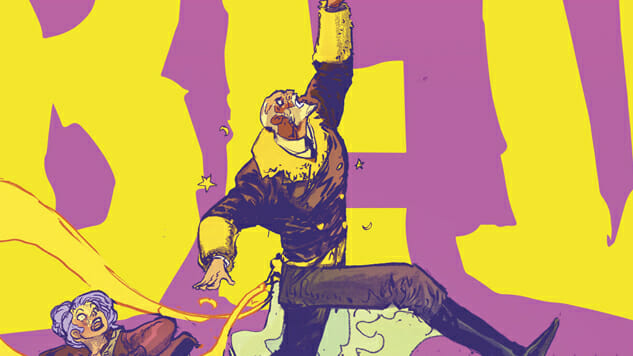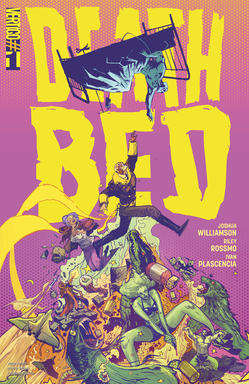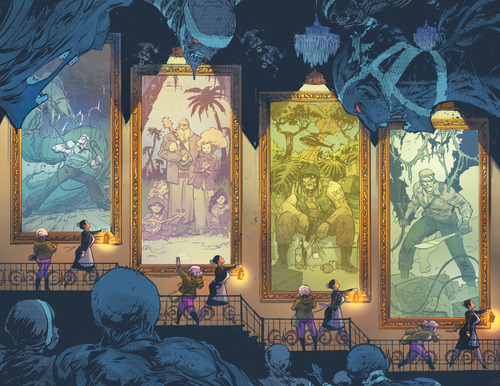Deathbed’s Joshua Williamson & Riley Rossmo on Life, Legacy & Nude Fight Scenes
Main Art by Riley Rossmo & Ivan Plascencia Comics Features Vertigo
 Vertigo, the storied mature-readers imprint of DC Comics, marks its 25th anniversary in 2018, and we don’t yet know much about how the publisher plans to celebrate the occasion. What we do know, however, is which new titles are ringing in Vertigo’s first quarter-century: Simon Spurrier and Rachel Stott’s Motherlands, about a mother/daughter bounty hunter duo, and Joshua Williamson and Riley Rossmo’s Deathbed.
Vertigo, the storied mature-readers imprint of DC Comics, marks its 25th anniversary in 2018, and we don’t yet know much about how the publisher plans to celebrate the occasion. What we do know, however, is which new titles are ringing in Vertigo’s first quarter-century: Simon Spurrier and Rachel Stott’s Motherlands, about a mother/daughter bounty hunter duo, and Joshua Williamson and Riley Rossmo’s Deathbed.
Centered around “Myth, hack, sex symbol [and] stark-raving lunatic” Antonio Luna, Deathbed finds the world’s greatest living adventure staring his mortality in the face—and searching for the perfect way to die. Of course, no death is a worthy one for Luna unless it, and his final words, are recorded for posterity, which is where frustrated young writer Valentine Richards comes in. But as Richards soon discovers, Luna’s life attracts more outrageous violence and drama than she can possibly imagine. In advance of the six-issue mini-series’ debut installment, out this week, Paste exchanged emails with Williamson, current DC superstar and writer of Ghosted and Nailbiter at Image, and Rossmo, prolific artist on books like Batman/The Shadow and Cowboy Ninja Viking, to discuss the outrageous action and very real reflections on legacy that make up Deathbed.
![]()
Paste: Before we get into Deathbed plot specifics, I’d love to know a bit more about how you developed the series together. What was your working process like, and how did you build the world of Antonio Luna together? Josh, how involved are you in Riley’s design process, and Riley, how much story input have you had?
Riley Rossmo: Josh and I have a pretty organic process. We talk a lot on Skype about what we’re going to do so when I put pencil to paper, even though it might not be what Josh was expecting 100% visually, it usually fulfils the conceptual idea we’d talked about. Since we talk most days the script is pretty loose. If I have an idea I usually just call Josh and ask what he thinks about adding a couple panels or changing a character design. Occasionally there’s a particular set piece I want to draw, and Josh finds a way to make it fit.
Joshua Williamson: Yeah, Riley and I have been talking about this series for a long time and so we’re on the same page with the big picture story beats. Normally with books like Flash or Nailbiter, I write a full script, but here, since Riley and I talk everything out, I just write a plot-first based script. It’s super loose and just gets the big intent down for each page. No panel breaks. And then Riley dives in and uses his insane imagination to up the craziness of each scene. Sometimes there are surprises but it’s always for the better. I leave all the design stuff and the visual look of the book to Riley—I love Riley’s ideas on art and storytelling.
I had the idea for the book a few years ago about a man on his deathbed looking back at his life and trying to see where he went wrong, or how he could have been better. Like, if you knew Death was coming…what would you do? Would you want to control it? Make your death some big grand thing? Or go quietly? What kind of legacy do you want to leave behind? Riley and I started to talk about how big and crazy that could get. All those conversations went into the first issue and are a part of our big ideas for the entire mini-series.

Deathbed Interior Art by Riley Rossmo & Ivan Plascencia
Paste: Luna is big, bold and comfortable fully naked. I’m getting Doc Savage and “The Most Interesting Man in the World” vibes from him. What was the genesis of a “seen it all, done it all” character like Luna?
Rossmo: Luna’s the distilled and pickled version of all pulp heroes. Initially I thought we’d go with a frailer, smaller Luna. As I got closer to drawing the book though, I realized Luna was going to be a bit more Nick Fury or Doc Savage. He may be old, but he’s tried all the anti-aging products and exercises there are.
Williamson: I’m fascinated about how long life can be and how many changes you can go through in one lifetime. Like, the person I was when I was 18 is very different than the person I am now. Even the person I was six years ago is drastically different. Sometimes you think back to a time of your life that was super intense and it feels like years but you realize it was a few short months. It’s interesting to me how we can reinvent ourselves sometimes like that. How life changes us. And so, with Luna, I wanted to show that. How he was this guy who, at the end of the day is afraid of commitment, and wanted to do it all. He wanted to live some big crazy life and he didn’t care the cost.
Luna is intended to be this very over-the-top and full-of-himself type of person who really believes he made all the right moves in his life. But here we confront with the idea that with age you can look back at your own life story and maybe realize that you were the bad guy of your own story.
So, Riley and I had a lot of conversations about him, his character, his vast life and what his arc was. Really, you’re seeing his final act. This is the end of his “heroes journey.”
Then we took all that and mixed it in with a guy who is sort of a horrible jerk person with the pulp hero feel from another era. It helps give him the air of having “lived.”
Paste: Riley—full-frontal male scenes are pretty rare in mainstream comics. Was this your first anatomically correct, Eastern Promises-style action sequence? Are you prepared for all of the tweets calling Luna a silver daddy?
Rossmo: A few of my earlier creator owned books have had male nudity, but nothing on this scale.
Williamson: Considering how toxic Luna is, I’d be surprised if people call him anything other than an asshole. But if people call him a silver daddy, that’s totally cool with us.

Deathbed Interior Art by Riley Rossmo & Ivan Plascencia
Paste: Riley, you also get to bust loose some of your creature design skills in this issue. What keeps you coming back to books where you can draw monsters and demons and things that go bump in the night? Which future foes can you tease for us?
Rossmo: I LOVE designing monsters. I love the challenge of discovering what’s unsettling to me…I think it’ll be a life-long journey. It’s something that just follows me. I’m inspired by images, and ideas that make me uncomfortable and synthesizing those ideas into characters and images that hopefully audiences react to in the same way. We’ll see more of the undead, cyber merfolk, werewolves, cannibal cultists and mutant jellyfish.
Paste: Josh, our viewpoint character is Valentine Richards, a failed novelist turned reporter. You’re writing Flash and Justice League books and one of your creator-owned series is heading to the screen soon. Was it cathartic to get in the head of a writer struggling at an earlier part of her career?
Williamson: A bit, yeah. I struggle with writing for a variety of reasons. Aiming for some idea of what I think is perfect, letting myself get distracted, over-thinking, whatever. And so, with Val I could express some of that frustration. Val for sure has writer’s block and imposter syndrome, and she’s let it put a pause on her writing and her life. And honestly, I can relate to some of that. Most of that. All of that. Her perspective on other’s lives is what makes her a great ghostwriter, but she’s always lacked the ability to turn that perspective inwards.
One thing in this series that Luna is obsessed with is endings and his last words. How his story ends. And he’s let that obsession blind him to some of his actions in the past. (And in the current.)
But Val is equally obsessed with first impressions, first words and how a story starts. So, showing that contrast with them and how Val reacts to meeting someone who is her opposite and how she finds him disgusting but also inspiring was interesting to me to write about.
Paste: When Valentine first arrives in Luna’s manor, she walks past a gallery of some of his greatest adventures. How much of Luna’s storied past should we expect to see firsthand?
Williamson: We do get some of the stuff from those giant portraits. They do tease some of what is to come. The idea with those was to help set the scene of who Luna was. What person has giant portraits of themselves like that? Who does that?
Originally, we had this big two-page spread early on that was a timeline with details of his whole life, but we cut it because we didn’t want to give away too much of the mystery of who Luna is. We felt we could show that over the course of the whole series.
We also didn’t want the book to be all flashbacks. So, each issue usually gets a two-page spread flashback that helps get the ball moving quickly so we can get more into how Luna’s past is affecting the present.
But didn’t Riley and Ivan [Plascencia] do a rad job with those paintings? That’s one of my favorite two-page spreads of the whole book.

Deathbed Interior Art by Riley Rossmo & Ivan Plascencia
Paste: While the first issue is a lot of chaotic fun, Deathbed also has undertones of legacy, and the stories we leave behind when we go. Was it tough to confront such a personal, emotional topic?
Rossmo: Deathbed is about confronting who I am and how my daughter will remember me as she grows up. It’s about trying to confront all the versions of who I am and trying to examine the events of our lives from an outside perspective. I think for Josh and me a lot of it is inspired by having become parents in the past couple of years.
Williamson: Yeah, without giving too much away the ideas of being a parent played a big role in this. The expectations our parents have for us and how we carry that in our lives…and then if we have children, how we pass that down.
But it’s also about death. How we handle it. We only get this one life, but at the same time we get many. I said early that I think our lives can be a form of reincarnation. That we can reinvent who we are, but it’s still us and we’re a sum of all our experiences good and bad. How do we look back at our lives when we’re done? So many people say they have regrets, and why is that? What do we want the end of our story to be? How do we want to be remembered?
In the end of the series, Luna has some very real talks about some of this stuff that was hard to write. I wanted to make sure that all the craziness did end with Luna and Val changing and confronting everything.
Paste: This year marks Vertigo’s 25th anniversary—how does it feel to launch a new series at the imprint during that milestone? Were there any Vertigo titles that were particularly influential for either of you growing up and entering the industry?
Rossmo: It’s pretty cool to be doing something at Vertigo. There are so many Vertigo books I love. Vimanarama, Preacher, Fables, Young Liars, Flinch are amazing. Vertigo has done so much horror/fantasy and crime stuff which have been so influential to my work. Paul Pope’s 100% has had a huge influence on how I approach mark making in my work over the years, and Edwardo Risso’s work on 100 Bullets and Johnny Double have taught me so much about compositions and storytelling.
Williamson: Preacher, for sure. That’s in my top five comics of all team, easy. Kill Your Boyfriend and Invisibles are huge for me. Those helped shape who I am as a person beyond just writing. Transmetropolitan and Y The Last Man, too. 100 Bullets is one that Riley and I talk about a lot. It’s an honor to work with Vertigo in its 25th Anniversary. I am 100% a Vertigo guy. I listed the above comics, but the Vertigo model really influenced my writing and my thoughts on publishing. If you look at the creator-owned books I’ve done over the last few years, you can hopefully see that.
